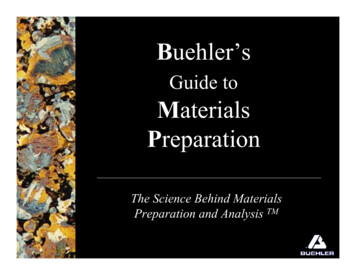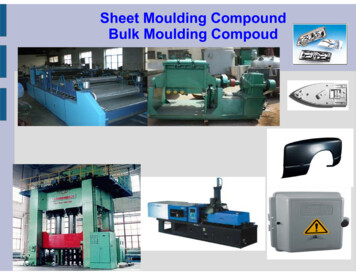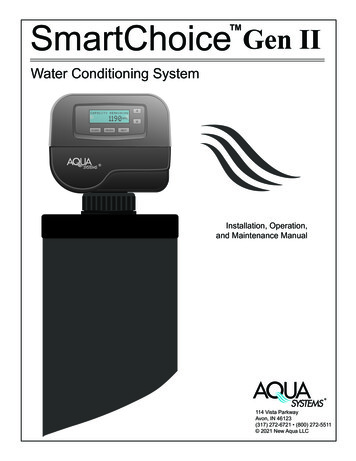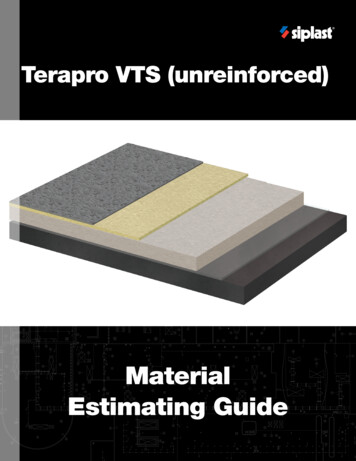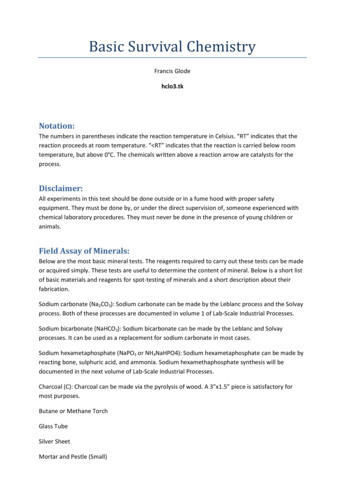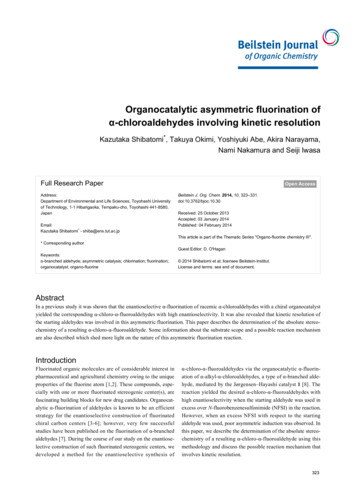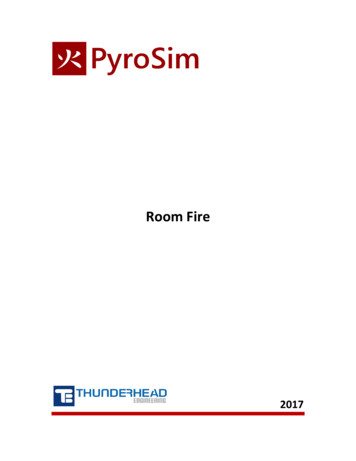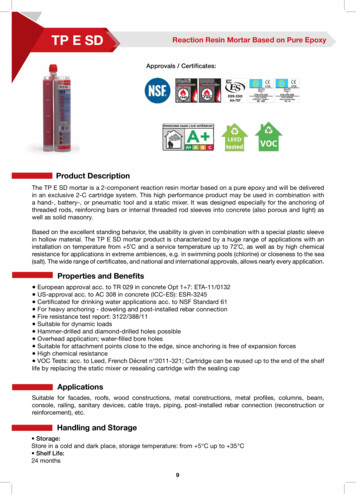
Transcription
TP E SDReaction Resin Mortar Based on Pure EpoxyApprovals / Certificates:Product DescriptionThe TP E SD mortar is a 2-component reaction resin mortar based on a pure epoxy and will be deliveredin an exclusive 2-C cartridge system. This high performance product may be used in combination witha hand-, battery-, or pneumatic tool and a static mixer. It was designed especially for the anchoring ofthreaded rods, reinforcing bars or internal threaded rod sleeves into concrete (also porous and light) aswell as solid masonry.Based on the excellent standing behavior, the usability is given in combination with a special plastic sleevein hollow material. The TP E SD mortar product is characterized by a huge range of applications with aninstallation on temperature from 5 C and a service temperature up to 72 C, as well as by high chemicalresistance for applications in extreme ambiences, e.g. in swimming pools (chlorine) or closeness to the sea(salt). The wide range of certificates, and national and international approvals, allows nearly every application.Properties and Benefits European approval acc. to TR 029 in concrete Opt 1 7: ETA-11/0132 US-approval acc. to AC 308 in concrete (ICC-ES): ESR-3245 Certificated for drinking water applications acc. to NSF Standard 61 For heavy anchoring - doweling and post-installed rebar connection Fire resistance test report: 3122/388/11 Suitable for dynamic loads Hammer-drilled and diamond-drilled holes possible Overhead application; water-filled bore holes Suitable for attachment points close to the edge, since anchoring is free of expansion forces High chemical resistance VOC Tests: acc. to Leed, French Décret n 2011-321; Cartridge can be reused up to the end of the shelflife by replacing the static mixer or resealing cartridge with the sealing capApplicationsSuitable for facades, roofs, wood constructions, metal constructions, metal profiles, columns, beam,console, railing, sanitary devices, cable trays, piping, post-installed rebar connection (reconstruction orreinforcement), etc.Handling and Storage Storage:Store in a cold and dark place, storage temperature: from 5 C up to 35 C Shelf Life:24 months9
TP E SDReaction Resin Mortar Based on Pure EpoxyApplications and Intended Use Underground:Cracked concrete, non-cracked concrete, light concrete, porous concrete, solid masonry, natural stone;hammer-drilled and diamond-drilled holes Anchor Elements:Threaded rods (zinc plated or hot dip, stainless steel and high corrosion resistance steel), reinforcing bars,internal threaded rods, profiled rod, steel section with undercuts (e.g. perforated section) Temperature Range:Base material temperature: 5 C up to 40 CCartridge temperature: min. 5 C; optimal 20 CBase material temperature after full curing: -40 C to 72 C Loading:Static; quasi-static and seismic loadingReactivityTemperature of basematerialGelling and workingtimeFull curing time in drybase materialFull curing time in wetbase material 5ºC120 min.50 h100 h 10ºC90 min.30 h60 h 20ºC30 min.10 h20 h 30ºC20 min.6h12 h 40ºC12 min.4h8h10
TP E SDReaction Resin Mortar Based on Pure EpoxyUsage Instructions - Concrete (for Threaded Rod and rebar)1- Drill a hole into the base material to the size and embedment depthrequired by the selected anchor.2a- For diamond-drilled holes, rinse until clear water appears. Then, cleanthe hole with a mechanical wire brush. After that, repeat the rinsing stepuntil clear water appears.or2b- Standing water must be removed before cleaning. Starting from the bottomof the bore hole, blow the hole clean with compressed air or a handpump aminimum of two times. If the bore hole ground is not reached, an extensionshall be used. The hand-pump can be used for anchor sizes up to bore holediameter 20 mm. For bore holes larger than 20 mm or deeper than 240 mm,compressed air (min. 6 bar) must be used.2c- Check brush diameter acc. to table A and attach the brush to a drillingmachine or a battery screwdriver. Brush the hole with an appropriate sizedwire brush db, min a minimum of two times. If the bore hole ground is notreached with the brush, a brush extension shall be used.or2d- Finally, blow the hole clean again with compressed air or a handpumpa minimum of two times. If the bore hole ground is not reached, anextension shall be used. The handpump can be used for anchor sizes upto bore hole diameter 20 mm. For bore holes larger than 20 mm or deeperthan 240 mm, compressed air (min. 6 bar) must be used.11
TP E SDReaction Resin Mortar Based on Pure Epoxy3- Attach a supplied static-mixing nozzle to the cartridge and load thecartridge into the correct dispensing tool. For every working interruptionlonger than the recommended working time as well as for new cartridges,a new static-mixer shall be used.4- Prior to inserting the anchor rod into the filled bore hole, the position ofthe embedment depth shall be marked on the anchor rods.5- Prior to dispensing into the anchor hole, squeeze out separately aminimum of three full strokes and discard non-uniformly mixed adhesivecomponents until the mortar shows a consistent red color.6- Starting from the bottom of the cleaned anchor hole, fill the hole up toapproximately two-thirds with adhesive. Slowly withdraw the static mixingnozzle as the hole fills to avoid creating air pockets. For embedment depthlarger than 190 mm, an extension nozzle shall be used. For overhead andhorizontal installation in bore holes bigger than 20 mm, a piston plug andextension nozzle shall be used. Observe the gel / working times given.7- Push the threaded rod or reinforcing bar into the anchor hole whileturning slightly to ensure positive distribution of the adhesive until theembedment depth is reached. The anchor should be free of dirt, grease,oil or other foreign material.8- Be sure that the anchor is fully seated at the bottom of the hole and thatexcess mortar is visible at the top of the hole. If these requirements are notmaintained, the application has to be renewed.9- Allow the adhesive to cure to the specified time prior to applying anyload or torque. Do not move or load the anchor until it is fully cured.10- After full curing, the add-on part can be installed with the max. torqueby using a calibrated torque wrench.12
TP E SDReaction Resin Mortar Based on Pure EpoxyCleaning of the Drill Hole - ConcreteBrushSteel wire, length 80 mm, M6 thread for drilling machine connectionBlowerPistonPlugTable A:Threaded rod(mm)Rebar(mm)M8Bore hole - øBrush - øMin. brush - ø10,012,010,5(mm)db (mm)db,min (mm)Piston plug(Nr.)M 108,012,014,012,5M 16,020,022,020,520,024,026,024,5# 2428,030,028,5# 28M 16M 20M 24Not necessaryM 2725,032,034,032,5# 32M 3028,035,037,035,5# 3537,039,037,5# 3740,041,540,5# 3842,044,042,0# 4236,046,048,046,0# 4640,050,052,050,0# 50M 3332,0M 36M 3913
TP E SDReaction Resin Mortar Based on Pure EpoxySetting Parameter - ConcreteAnchor size(Threaded rod)Edge distanceM8 M10 M12 M16 M20 M24 M27 M30 M33 M36 M39Ccr,N[mm]113135165188255304342379400436472Min. edge distance Cmin[mm]40506080100120135150165180195Axial Min. axial ment depthhef[mm]8090110125170210250280320350380Min. part thicknesshmin[mm]Anchor diameterd[mm]810121620242730333639Drill diameterdo[Nm]1012141824283235374246Installation 10ø12ø14ø16ø20ø25ø28ø32ø36ø40Anchor size(Rebar)Edge distancehef 30 mmhef 2doCcr,N[mm]97121139170180219274298330372413Min. edge distance Cmin[mm]4050607080100125140160180200Axial Min. axial ent depthhef[mm]8090110115125170210250280340360Min. part thicknesshmin[mm]Anchor diameterd[mm]810121416202528323640Drill diameterdo[mm]1214161820243235404650hef 30 mmhef 2do14
TP E SDReaction Resin Mortar Based on Pure EpoxyPerformance Data - Concrete1)For threaded rod in hammer-drilled holesTENSION LOADS - Design method A acc. to EOTA Technical Report TR 029, characteristic values fortension loading.Anchor 781321393370436521Steel failureCharacteristic tension resistance, steel, zincplated or hot dip, property class 5.8Characteristic tension resistance, steel, zincplated or hot dip, property class 8.8NRk,sPartial safety factor1,50γMs,NCharacteristic tension resistance, stainlesssteel A4 and HCR[kN]NRk,sPartial safety factor2641591101722471,87γMs,N2,86Pull-out and concrete cone failure2)Characteristic bond resistance in concrete C20/2524 C/40 C3)43 C/60 C3)43 C/72 C3)uncracked concrete30426288139190254317365435512cracked 138172199238279811172232486479100119140uncracked concretecracked concreteuncracked concreteNRk,p [kN]NºRk,ccracked concretePartial safety factor (dry and wet)γMp ge Axial distanceScr,N[mm]Embedment depthIncreasing factors for concrete2 x Ccr,N(fck0,11) / 1,42cSplitting failureEdge distanceCcr,sp[mm]Axial distanceScr,sp[mm]Partial safety factor (dry and wet)γMspCcr,N 2 hef (2,5 - h/hef) 2,4 hef2 x Ccr,sp1,82,1The data in this table is intended to be used together with the design provisions of ETAG Technical Report TR 029.1) For more details, as well as values in water-filled concrete, see ETA 11 / 0132.2) Shall be determined acc. to this table or clause 5.2.2.4, EOTA Technical Report TR 029. The smaller value is decisive.3) Short-term temperature / Long-term temperature. Long-term concrete temperatures are roughly constant over significant periodsof time. Short-term elevated temperatures are those that occur over brief intervals, e.g. as a result of diurnal cycling.15
TP E SDReaction Resin Mortar Based on Pure EpoxyPerformance Data - Concrete1)For threaded rod in diamond-drilled holesTENSION LOADS - Design method A acc. to EOTA Technical Report TR 029, characteristic values fortension loading.Anchor 781321393370436521Steel failureCharacteristic tension resistance, steel, zincplated or hot dip, property class 5.8Characteristic tension resistance, steel, zincplated or hot dip, property class 8.8NRk,sγMs,NPartial safety factorCharacteristic tension resistance, stainlesssteel A4 and HCR1,50[kN]NRk,s264159γMs,NPartial safety factor1101722471,872,86Pull-out and concrete cone failure2)Characteristic bond resistance in concrete C20/2524 C/40 C3)43 C/60 C3)uncracked concrete3)43 C/72 CPartial safety factor (dry and wet)NRk,p 87117132166198233172535537910611914917821013γMp ge Axial distanceScr,N[mm]Embedment depthIncreasing factors for concrete2 x Ccr,N(fck0,11) / 1,42cSplitting failureEdge distanceCcr,sp[mm]Axial distanceScr,sp[mm]Partial safety factor (dry and wet)γMspCcr,N 2 hef (2,5 - h/hef) 2,4 hef2 x Ccr,sp1,82,1The data in this table is intended to be used together with the design provisions of ETAG Technical Report TR 029.1) For more details, as well as values in water-filled concrete, see ETA 11 / 0132.2) Shall be determined acc. to this table or clause 5.2.2.4, EOTA Technical Report TR 029. The smaller value is decisive.3) Short-term temperature / Long-term temperature. Long-term concrete temperatures are roughly constant over significant periodsof time. Short-term elevated temperatures are those that occur over brief intervals, e.g. as a result of diurnal cycling.16
TP E SDReaction Resin Mortar Based on Pure EpoxyPerformance Data - ConcreteFor threaded rod in hammer- and diamond-drilled holesSHEAR LOADS - Design method A acc. to EOTA Technical Report TR 029, characteristic values for shear loading.Anchor size1)M8M10M12M16M20M24M27M30M33M36M39Steel failure without lever armCharacteristic tension resistance, steel, zincplated or hot dip, property class ic tension resistance, steel, zincplated or hot dip, property class 05244Partial safety factorCharacteristic tension resistance, stainlesssteel A4 and HCR1,25γMs,V[kN]VRk,sPartial safety factor13203055861241,56γMs,V2,38Steel failure with lever armCharacteristic bending moment, steel, zincplated or hot dip, property class racteristic bending moment, steel, zincplated or hot dip, property class 331123154719762580Partial safety factorCharacteristic bending moment, stainlesssteel A4 and HCR1,25γMs,VM[Nm]0Rk,SPartial safety factor2652922324547841,56γMs,V2,38Concrete Pry-out failureFactor k2,0Partial safety factor1,5γMcpConcrete edge failureEffective length of anchor in shear loadingOutside diameter of anchorPartial safety ]10121418242832353742461,5γMcThe data in this table is intended to be used together with the design provisions of EOTA Technical Report TR 029.1) Sizes M33 up to M39 are not covered by ETAs.17
TP E SDReaction Resin Mortar Based on Pure EpoxyPerformance Data - Concrete1)For rebar in hammer-drilled holesTENSION LOADS - Design method A acc. to EOTA Technical Report TR 029, characteristic values for tension loading.Anchor 8436285111173270339442560691Steel failureCharacteristic tension resistance, BSt 500 Sacc. to DIN 488-2:1986 or E DIN 488-2:20062)NRk,sPartial safety factor[kN]1,40γMs,NPull-out and concrete cone failure3)Characteristic bond resistance in concrete C20/2524 C/40 C4)43 C/60 C4)43 C/72 C4)uncracked concrete2840546675128181242310423498cracked 4318325029491319202537587799135158uncracked concretecracked concreteuncracked concreteNRk,p [kN]NºRk,c5)cracked concretePartial safety factor (dry and 136γMp ge Axial distanceScr,N[mm]Embedment depthIncreasing factors for concrete2 x Ccr,N(fck0,11) / 1,42cSplitting failureEdge distanceCcr,spAxial distanceScr,spPartial safety factor (dry and wet)Ccr,N 2 hef (2,5 - h/hef) 2,4 hef[mm][mm]γMsp2 x Ccr,sp1,82,1The data in this table is intended to be used together with the design provisions of ETAG Technical Report TR 029.1) For more details, as well as values in water-filled concrete see ETA 11 / 0132.2) For reinforcing bars that do not comply with DIN 488: the characteristic resistance NRk,s shall be determined acc. to TechnicalReport TR 029, equation (5.1).3) Shall be determined acc. to this table or clause 5.2.2.4, EOTA Technical Report TR 029. The smaller value is decisive.4) Short-term temperature / Long-term temperature. Long-term concrete temperatures are roughly constant over significant periodsof time. Short-term elevated temperatures are those that occur over brief intervals, e.g. as a result of diurnal cycling.5) Sizes 8 and 10 (cracked concrete only), as well as 36 and 40, are not covered by ETAs.18
TP E SDReaction Resin Mortar Based on Pure EpoxyPerformance Data - Concrete1)For rebar in diamond-drilled holesTENSION LOADS - Design method A acc. to EOTA Technical Report TR 029, characteristic values for tension loadingAnchor 8436285111173270339442560691Steel failureCharacteristic tension resistance, BSt 500 Sacc. to DIN 488-2:1986 or E DIN 488-2:20062)NRk,sPartial safety factor[kN]1,40γMs,NPull-out and concrete cone failure3)Characteristic bond resistance in concrete C20/2524 C/40 C4)43 C/60 C4)uncracked concrete43 C/72 C4)Partial safety factor (dry and wet)NRk,p 49112114119222613172528355382110127173204γMp ge xial distanceScr,N[mm]Embedment depthIncreasing factors for concrete2 x Ccr,N(fck0,11) / 1,42cSplitting failureEdge distanceCcr,spAxial distanceScr,spPartial safety factor (dry and wet)Ccr,N 2 hef (2,5 - h/hef) 2,4 hef[mm][mm]γMsp2 x Ccr,sp1,82,1The data in this table is intended to be used together with the design provisions of ETAG Technical Report TR 029.1) For more details, as well as values in water-filled concrete, see ETA 11 / 0132.2) For reinforcing bars that do not comply with DIN 488: the characteristic resistance NRk,s shall be determined acc. to TechnicalReport TR 029, equation (5.1).3) Shall be determined acc. to this table or clause 5.2.2.4, EOTA Technical Report TR 029. The smaller value is decisive.4) Short-term temperature / Long-term temperature. Long-term concrete temperatures are roughly constant over significant periodsof time. Short-term elevated temperatures are those that occur over brief intervals, e.g. as a result of diurnal cycling.5) Sizes 8 and 28 up to 40 are not covered by ETAs.19
TP E SDReaction Resin Mortar Based on Pure EpoxyPerformance Data - ConcreteFor rebar in hammer- and diamond-drilled holesSHEAR LOADS - Design method A acc. to EOTA Technical Report TR 029, characteristic values for shear loading.Anchor l failure without lever armCharacteristic tension resistance, BSt 500 Sacc. to DIN 488-2:1986 or E DIN 488-2:20061)VRk,s[kN]γMs,VPartial safety factor1,5Steel failure with lever armCharacteristic bending moment, BSt 500 Sacc. to DIN 488-2:1986 or E DIN 488-2:20062)M0Rk,s[Nm]3365112178265γMs,VPartial safety factor5181,5Concrete pry-out failureFactor k2,0γMcpPartial safety factor1,5Concrete edge failureEffective length of anchor in shear loadingOutside diameter of anchorPartial safety ]1214161820243235404650γMc1,5The data in this table is intended to be used together with the design provisions of EOTA Technical Report TR 029.1) For reinforcing bars that do not comply with DIN 488: the characteristic resistance VRk,s shall be determined acc. to Technical ReportTR 029, equation (5.5).2) For reinforcing bars that do not comply with DIN 488: the characteristic resistance MORk,s shall be determined acc. to Technical ReportTR 029, equation (5.6b).3) Sizes 36 and 40 are not covered by ETAs.20
TP E SDReaction Resin Mortar Based on Pure EpoxyPerformance Data - Concrete (Seismic C1)Design under seismic action acc. to TR 045The decision of the selection of the seismic performance category is in the responsibility of each individualMember State. Furthermore, the values of ag S assigned to the seismicity levels may be different inthe National Annexes to EN 1998-1:2004 (EC8) compared to the values given in the following table. Therecommended categories C1 and C2 in the table are given in the case that no National requirements aredefined.Recommended Seismic Performance CategoriesSeismicity level a)Importance Class acc. to EN 1998-1:2004, 4.2.5ag SVery lowlow b)b)c)Iag S 0,05 gIIIIVNo additional requirement0,05 g ag S 0,1 g low b)IIC1ag S 0,1 gC1 d) or C2 e)C1a) The values defining the seismicity levels may be found in the National Annex of EN 1998-1.b) Definition according to EN 1998-1: 2004, 3.2.1.c) ag Design ground acceleration on Type A ground (EN 1998-1: 2004, 3.2.1),S Soil factor (see e.g. EN 1998-1: 2004, 3.2.2).d) C1 attachments of non-structural elements.e) C2 for connections between structural elements of primary and/or secondary seismic members.Calculation of Characteristic Seismic Resistance Rk,seisTension load: Rk,seis αgap αseis αN,seis R0kwhere R 0k NRk,s, NRk,p, NRk,c, NRk,sp (from design in cracked concrete)αN,seis 1,0 for NRk,c, NRk,spαN,seis for NRk,s, NRk,p see following Tablesαgap see following Tablesαseis see following TablesShear load: Rk,seis αgap αseis αV,seis R0kwhere R0k VRk,s, VRk,c, VRk,cp (from design in cracked concrete)αV,seis 1,0 for VRk,c, VRk,cpαV,seis for VRk,s see following Tablesαgap see following Tablesαseis see following Tables21C2C2
TP E SDReaction Resin Mortar Based on Pure EpoxyPerformance Data - Concrete (Seismic C1)Reduction factors αN,seis, αV,seis, αgap and αseisAnchor size threaded ension loadSteel failure (NRk,s)αN,seis[-]Combined pull-out and concrete ar loadSteel failure without lever arm (VRk,s)Anchor size rebar1)0,70ø8ø10ø12ø14ø16ø20ø25ø28Tension loadSteel failure (NRk,s)αN,seis[-]Combined pull-out and concrete ar loadSteel failure without lever arm (VRk,s)LoadingTensionαgapαseis - Single fastenerαseis - Fastener groupSteel failure1,01,01,0Pull-out failure1,01,00,85Combined pull-out and concrete failure1,01,00,85Concrete cone failure1,00,850,75Failure modesSplitting failureSteel failure without lever armShear0,70Steel failure with lever arm1,01,00,850,5 1)1,00,85NPD 2)Concrete edge failure0,51)Concrete pry-out failure0,51)1) The limitation for size of the clearance hole is given in TR 029 Table 4.1,αgap 1,0 in case of no clearance between fastener and fixture.2) No Performance Determined22NPD 2)NPD 2)1,00,850,850,75
TP E SDReaction Resin Mortar Based on Pure EpoxyRecommended Loads - ConcreteFor threaded rod in hammer-drilled holesThe recommended loads are only valid for single anchor for a roughly design, if the following conditions arevalid:c c cr,N s s cr,N h 2 x hefIf the conditions are not fulfilled, the loads must be calculated acc. to EOTA Technical Report TR 029.The safety factors are already included in the recommended loads.Recommended tension loadAnchor size (steel quality)24 C/40 C43 C/60 C43 C/72 CRecommendedshear loadwithout leverarm2)uncrackedconcreteM8 M10 M12 M16 M20 M24 M27 M30 M33 M36 tVRec,statVRec,seis[kN][kN][kN]4)Embedment depthhef[mm]8090110125170210250280320350380Edge Axial distanceScr,N[mm]2xccr,N1) Sizes M8 and M10 (cracked concrete only), as well as M33 up to M39 are not covered by ETAs.2) Shear load with lever arm acc. to TR 029.3) NRec,stat , VRec,stat Recommended Load under static and quasi-static action4) NRec,seis , VRec,seis Recommended Load under seismic action23
TP E SDReaction Resin Mortar Based on Pure EpoxyRecommended Loads - ConcreteFor threaded rod in diamond-drilled holesThe recommended loads are only valid for single anchor for a roughly design, if the following conditions arevalid:c c cr,N s s cr,N h 2 x hefIf the conditions are not fulfilled, the loads must be calculated acc. to EOTA Technical Report TR 029.The safety factors are already included in the recommended loads.Recommendedtension loadAnchor size (Steel quality 5.8)1)24 C/40 CuncrackedconcreteNRec43 C/60 CuncrackedconcreteNRec43 C/72 ndedshear loadwithout leverarm2)M8M10M12M16 M20M24M27M30M33M36 45,155,463,775,387,095,7[kN][kN][kN]Embedment depthhef[mm]8090110125170210250280320350380Edge xial distanceScr,N[mm]2xccr,N1) Sizes M8 and M27 up to M39 are not covered by ETAs.2) Shear load with lever arm acc. to TR 029.24
TP E SDReaction Resin Mortar Based on Pure EpoxyRecommended Loads - ConcreteFor rebar in hammer-drilled holesThe recommended loads are only valid for single anchor for a roughly design, if the following conditions arevalid:c c cr,N s s cr,N h 2 x hefIf the conditions are not fulfilled, the loads must be calculated acc. to EOTA Technical Report TR 029.The safety factors are already included in the recommended loads.Recommended tension loadAnchor size (BSt 500)1)24 C/40 C43 C/60 C43 C/72 CRecommendedshear loadwithout nt depthhef[mm]8090110115125170210250280340360Edge Axial distanceScr,N[mm]2xccr,N1) Sizes 8 and 10 (cracked concrete only), as well as 36 and 40 are not covered by ETAs.2) Shear load with lever arm acc. to TR 029.3) NRec,stat , VRec,stat Recommended Load under static and quasi-static action4) NRec,seis , VRec,seis Recommended Load under seismic action25
TP E SDReaction Resin Mortar Based on Pure EpoxyRecommended Loads - ConcreteFor rebar in diamond-drilled holesThe recommended loads are only valid for single anchor for a roughly design, if the following conditions arevalid:c c cr,N s s cr,N h 2 x hefIf the conditions are not fulfilled, the loads must be calculated acc. to EOTA Technical Report TR 029.The safety factors are already included in the recommended loads.Anchor size (BSt 500)1)uncrackedconcreteNRec43 C/60 CuncrackedconcreteNRec43 C/72 CuncrackedconcreteNRecRecommendedshear loadwithout leverarmuncrackedconcreteRecommendedtension load24 C/40 ,026,241,060,168,085102116Embedment depthhef[mm]8090110115125170210250280340360Edge xial distanceScr,N[mm]2xccr,N1) Sizes 8 and 28 up to 40 are not covered by ETAs.2) Shear load with lever arm acc. to TR 029.Fire ResistanceFire resistance time in combination with threaded rods (M8 to M30) made of zinc plated steel, property class5.8 or higher as well as stainless steel A4-70.Fire resistance time in minutesAnchor size30 max F [kN]60 max F [kN]90 max F [kN]120 max F [kN]M8 0,90 0,50 0,30 0,20M10 3,20 1,80 1,10 0,75M12 4,20 2,30 1,40 0,90M16 8,25 5,30 3,80 3,00M20 17,25 10,20 6,70 5,00M24 24,85 14,75 9,70 7,20M30 39,50 23,40 15,40 11,35The special details acc. to the Test Report 3122/388/11/must be observed.26
TP E SDReaction Resin Mortar Based on Pure EpoxyChemical ResistanceResults shown in the table are applicable to brief periods of chemical contact with full cured adhesive (e.g. temporary contact withadhesive during a spill).27
The TP E SD mortar is a 2-component reaction resin mortar based on a pure epoxy and will be delivered . Storage: Store in a cold and dark place, storage temperature: from 5 C up to 35 C . M8 M10 M12 M16 M20 M24 M27 M30 M33 M36 M39 Edge distance C cr,N [mm] 113 135 165 188 255 304 342 379 400 436 472

